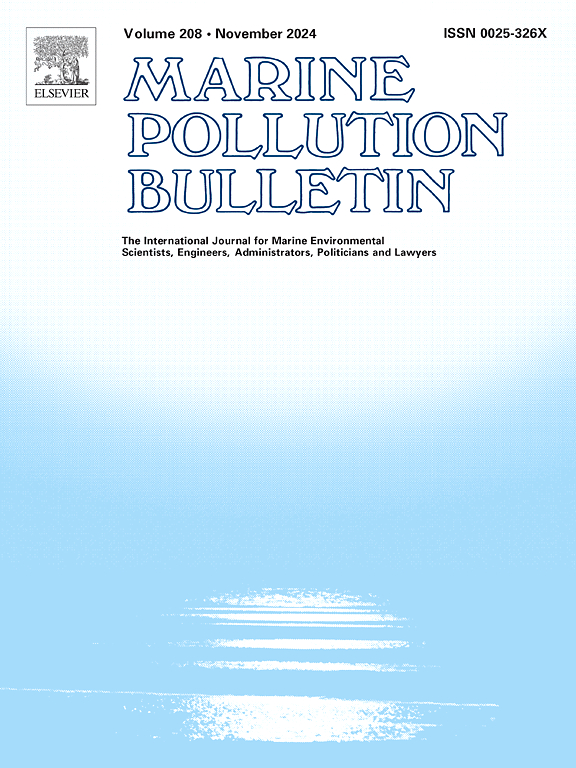评估微塑料对印度西海岸spadenose shark (Scoliodon laticaudus)性腺健康的影响
IF 5.3
3区 环境科学与生态学
Q1 ENVIRONMENTAL SCIENCES
引用次数: 0
摘要
微塑料(MPs)等污染物对人类和动物的健康有害,并降低环境质量。这些颗粒可通过食物链被吸收并在海洋生物群中积累,从而对各种生理过程产生不利影响。鲨鱼通常在海洋食物链中处于较高的营养水平,可能会表现出最高的MPs积累。然而,MPs在鲨鱼中的流行及其对生理的潜在影响尚不清楚。为了解决这一差距,我们调查了印度西海岸spadenose shark (Scoliodon laticaudus)胃肠道(GI)和性腺中的MP浓度。在所有水样、97.9%的胃肠道样本和95%的性腺组织样本中均检测到MPs,其中性腺的MPs浓度最高。纤维(85%)是主要类型,其次是薄片(11.2%)和薄膜(3%)。雌性生殖腺MPs浓度显著高于雄性。然而,在男性中,MP浓度与性腺指数(GSI)呈负相关,表明潜在的生理影响。拉曼光谱识别出聚乙烯和聚酰胺聚合物以及其他污染物。这些发现强调了MP在鲨鱼组织中的广泛存在及其对生殖健康的潜在影响。本文章由计算机程序翻译,如有差异,请以英文原文为准。
Assessing the impact of microplastics on gonadal health of the spadenose shark (Scoliodon laticaudus) on the west coast of India
Pollutants such as microplastics (MPs) are detrimental to the health of humans, animals and reduce the quality of the environment. These particles can be ingested and accumulate in marine biota through the food chain leading to adverse effects on various physiological processes. Sharks, which typically occupy higher trophic levels in the marine food chain, may exhibit the highest accumulation of MPs. However, the prevalence of MPs in sharks and their potential impact on physiology are not well understood. To address this gap, we investigated MP concentrations in the gastrointestinal tract (GI) and gonads of the spadenose shark (Scoliodon laticaudus) on the west coast of India. MPs were detected in all water samples, 97.9 % of the GI tract samples and 95 % of gonadal tissue samples, with gonads exhibiting the highest MP concentrations. Fibres (85 %) were the dominant type, followed by flakes (11.2 %) and films (3 %). Female gonads had a significantly higher concentration of MPs than males. However, in males, a negative correlation between MP concentration and gonadosomatic index (GSI) indicated potential physiological impacts. Raman spectroscopy identified polyethylene and polyamide polymers along with other contaminants. These findings underscore the widespread presence of MP in shark tissues and their potential impact on reproductive health.
求助全文
通过发布文献求助,成功后即可免费获取论文全文。
去求助
来源期刊

Marine pollution bulletin
环境科学-海洋与淡水生物学
CiteScore
10.20
自引率
15.50%
发文量
1077
审稿时长
68 days
期刊介绍:
Marine Pollution Bulletin is concerned with the rational use of maritime and marine resources in estuaries, the seas and oceans, as well as with documenting marine pollution and introducing new forms of measurement and analysis. A wide range of topics are discussed as news, comment, reviews and research reports, not only on effluent disposal and pollution control, but also on the management, economic aspects and protection of the marine environment in general.
 求助内容:
求助内容: 应助结果提醒方式:
应助结果提醒方式:


